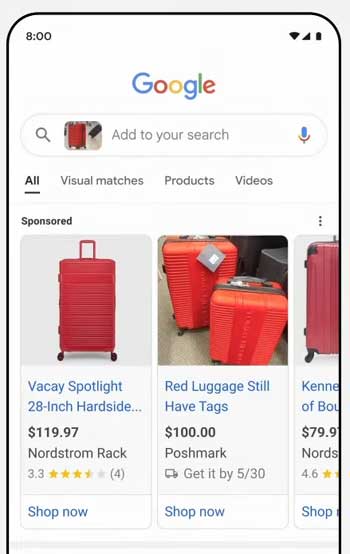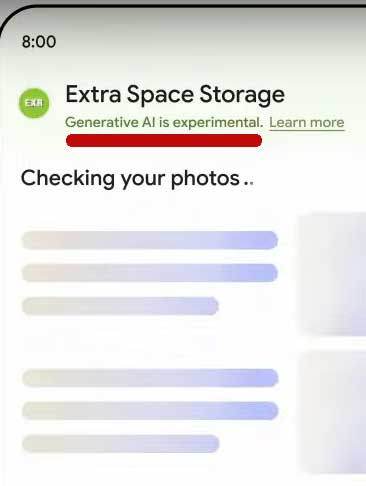
Google Introduces Search Ads with AI Assistant Features

Discover how Google's latest search ads incorporate paid recommendations that mimic AI-generated responses, providing users with a seamless and interactive search experience.
At Google's Marketing Live event, a keynote introduced a groundbreaking AI-powered visual search feature that incorporates advertisements seamlessly into AI-assisted search results. This innovative approach blurs the distinction between AI-generated search results and ads, creating a more engaging experience for users.
Google Lens, a highly useful app, takes on a new dimension by blurring the boundary between assisting users and guiding them towards making purchases. This unique method of leveraging AI to interact with potential customers is so innovative that the presenter refrains from labeling it as advertising, avoiding the use of that term altogether.
Visual Search Traffic Opportunity?
Sylvanus Bent, the Group Product Manager at Google, kicks off the presentation by introducing the new version of Google Lens visual search. This latest version is designed to help users easily access information and locate where they can make purchases.
Sylvanus shared that websites could benefit from the new method of searching by receiving more traffic. He mentioned that visual search allows users to explore things that catch their eye, whether it's taking a photo with a lens or searching on social media. Recently, a redesigned results page for Visual search was announced.
Soon, you will not only see visual matches but also a variety of results such as images, videos, web links, and facts from the knowledge graph. This will provide people with the information they need and open up new opportunities for websites to be found.
It is difficult to predict if this will increase search traffic to websites and the quality of that traffic. Will visitors stay to read an article or engage with a product review?
Visual Search Results
Sylvanus gives an example of a situation at the airport baggage claim where someone admires another person's bag. He mentions that by simply taking a photo of the bag, Google Lens can show them where to buy similar ones.
Screenshot Of Shopping Ads ad the top of a Google Lens visual search
He explains:
No need for words, just use Lens to snap a photo and instantly see purchase options.
For the first time, shopping ads will show up at the top of linked search results, allowing businesses to provide consumers with what they are seeking.
These are shopping ads with lots of images displayed prominently at the top of search results. Despite being a bit bothersome, this is nothing compared to the future of advertising on Google search ads. Google is planning to introduce a new level of advertising where paid promotions will be seamlessly integrated into interactions with an AI Assistant. This will make it easier for users to make purchases based on their interests.
Interactive Search Shopping
Sylvanus then talks about a new type of AI-powered search experience that includes advertising. However, he prefers not to use the term "advertising," instead referring to it as an interactive search shopping experience. He believes that it is more than just an offer, but rather a unique and engaging experience for users.
He's correct in avoiding the term "advertisement" as the concept he is discussing extends beyond traditional advertising. It merges search and advertising in the realm of AI-generated recommendations and sponsored suggestions.
Sylvanus elaborates on the functionality of this innovative shopping experience:
Imagine a world where search ads are more than just offers - they are experiences that allow you to connect directly with your customers. We are currently exploring search ads with AI-powered recommendations in various industries. Let me share with you an upcoming example that showcases this concept, with more exciting developments to come in the shopping realm.
For instance, consider someone looking to store their furniture temporarily and turning to Google for short-term storage options. What unfolds is a search for local short-term storage that transforms into a dynamic ad experience. This experience seamlessly guides the searcher towards adding packing supplies to their shopping cart.
He narrated how it works:
“You search for short term storage and you see an ad for extra space storage. Now you can click into a new dynamic ad experience.
You can easily upload photos of the rooms in your house to show your furniture and extra storage space. Google's AI will then generate a description of your belongings for you to confirm. Based on this information, you will receive a recommendation for the suitable size and type of storage unit, as well as the necessary packing supplies. Simply visit the website to finalize the transaction.
This service goes above and beyond the typical ad by providing all the assistance you need, except for physically moving your belongings. It's pretty impressive!
Step 1: Search For Short Term Storage
When clicked, the advertisement in the screenshot appears to lead to an AI-assisted search, but it actually turns out to be an interactive advertisement.
Step 2: Upload Photos For “AI Assistance”
This image shows an advertisement cleverly disguised within an AI-assisted search context. This tactic is similar to advertorials, where ads are camouflaged as articles. By using phrases like "Let AI do the heavy lifting" and "AI-powered recommendations," the true nature of the advertisement is hidden beneath the guise of AI-search.
Step 3: Images Chosen For Uploading
The above screenshot shows how a user uploads an image to the AI-powered advertisement within the context of an AI-powered search app.
The Word “App” Masks That This Is An Ad
Screenshot of interactive advertisement for that identifies itself as an app with the words "This app will only have access to the photos you select"
Here is a snapshot showing how a user can add a picture to the AI-driven interactive ad on a visual search engine. The term "app" is used to make it seem like the user is engaging with an app rather than an ad.
Upload Process Masks The Advertising Context
Screenshot of interactive advertisement that uses the context of an AI Assistant to mask that this is an advertisement
The phrase “Generative AI is experimental” contributes to the illusion that this is an AI-assisted search.
Step 4: Upload Confirmation
In step 4 the “app” advertisement is for confirming that the AI correctly identified the furniture that needs to be put into storage.
Step 5: AI “Recommendations”
The above screenshot shows “AI recommendations” that look like search results.
The Recommendations Are Ad Units
Those recommendations are actually ad units that when clicked takes the user to the “Extra Space Storage” shopping website.
Step 6: Searcher Visits Advertiser Website
Blurring The Boundaries
The Google keynote speaker is talking about blending paid product suggestions into AI-powered searches. It's so innovative that they don't even refer to it as traditional advertising. This approach blurs the distinction between AI-assisted search and advertising. When does a useful AI search turn into a tool for promoting paid suggestions?
Watch The Keynote At The 32 Minute Mark
Featured Image by Shutterstock/Ljupco Smokovski
Editor's P/S:
The future of search advertising is here, and it's more immersive and interactive than ever before. Google's new AI-powered visual search feature seamlessly integrates paid promotions into AI-assisted search results, creating a more engaging experience for users. This innovative approach blurs the distinction between search and advertising, making it easier for businesses to reach their target audience and for users to discover new products and services.
This new approach to advertising is more than just a way to sell products; it's a way to provide users with a more personalized and relevant experience. By leveraging AI to understand users' interests and needs, Google can deliver ads that are tailored to each individual user. This makes the advertising experience more relevant and less intrusive, which is a win-win for both businesses and users.
















